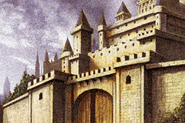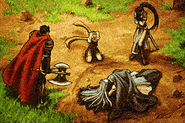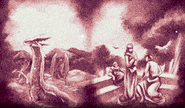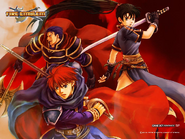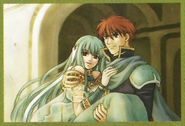Fire Emblem, released in Japan as Fire Emblem: Rekka no Ken (ファイアーエムブレム 烈火の剣, Lit. "Fire Emblem: Blazing Sword" and also known as "Fire Emblem: The Sword of Flame", according to the Fire Emblem Museum [1], and as "Fire Emblem: The Blazing Blade" by the Fire Emblem Heroes official website), is a Japanese tactical role-playing game for the Game Boy Advance, developed by Intelligent Systems and published by Nintendo. The game was released on April 25, 2003 in Japan, November 3, 2003 in North America, and July 16, 2004 in Europe.
It is the seventh game of the Fire Emblem series, the second game in the series to be released for the Game Boy Advance, and the first to be released in both North America and Europe. This game introduced Fire Emblem to the Western audience. It is the prequel to Fire Emblem: Binding Blade, and takes place over two years in game, with the events of Fire Emblem: Binding Blade occurring 20 years after that. Roy, the hero of Fire Emblem: Binding Blade is born sometime within 5 years after the conclusion of Rekka no Ken. Fire Emblem averages an 88.3 percent rating on Game Rankings which makes it the fourth highest rated Fire Emblem game on Game Rankings.
Characters
List of characters in Fire Emblem: Rekka no Ken
Chapters
List of chapters in Fire Emblem: Rekka no Ken
Plot
Introduction
The game opens with text describing ancient historical events in the world of Fire Emblem. 979 years before the events of the game take place, man and dragon coexisted in the world. However, this peace was broken when man began fighting against the dragons in a bitter war known as the Scouring. Upon their defeat, the dragons vanished from the world and man began to flourish as the sole dominant species.
Lyn's Tale (Prologue - 10)

Lyn, the protagonist of the introduction/tutorial.
The game's narrative starts in the plains of Sacae. The player character, a Tactician (a male named Mark, born in January, by default), is found by a girl named Lyn. She was recently orphaned due to bandits attacking her tribe, and decides to travel with Mark. In a nearby town they meet Kent and Sain, who reveal that Lyn is heir to the throne of Caelin. However, Lyn's existence is an obstacle to Lundgren, the brother of Lyn's grandfather Hausen, who desires to succeed his brother as the marquess. Lundgren continually attempts to kill Lyn and her grandfather.

Before setting out for Caelin, Lyn, Kent, and Cain visit a temple in order to pray before the Mani Katti, a sacred blade. After defeating attacking group of mercenaries and rescuing the priest, Lyn discovers that she is the chosen wielder of the Mani Katti. Lyn travels from Sacae to Caelin, meeting new allies and enemies along the way. Among these are the bard Nils and his sister, the dancer Ninian, who are being pursued by a shadowy organization known as the Black Fang. Lyn eventually arrives at Lundgren's stronghold, defeats him, and reunites with her grandfather.
This story mostly serves as a tutorial.
After the conclusion of this story, the player will proceed to Eliwood’s or Hector 's tale.
Eliwood's Tale (or Hector's Tale) (11 - Final)
To the Dragon's Gate (11 - 19 (20H))
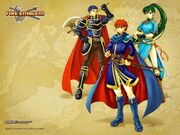
The heirs to the thrones of Pherae, Ostia, and Caelin: Eliwood, Hector, and Lyn, respectively.
One year later (Post-Scouring year 980), Lyn's friend Eliwood is leaving Pherae in search of his missing father, Marquess Elbert of Pherae. As he and his escorts prepare to leave the area, bandits attack a local village. Mark, the Tactician, is at the village, and Eliwood acquires the aid of Mark and other characters to take down the bandits. In Ostia, Marquess Uther did not want to take action in the disappearance of Elbert, but his younger brother and Eliwood's friend, Hector sets out to assist Eliwood. Eliwood then heads to Santaruz, where he meets his friend Hector, brother of Marquess Uther of Ostia. Marquess Santaruz’s dying words direct the group to Laus, where it is revealed that Marquess Laus is working with the Black Fang, a group of assassins, and intends to take over the world. With him is a mysterious man named Ephidel. Marquess Laus sends his son Erik to kill Eliwood and Hector. After the capture of Castle Laus, Erik confesses that one year ago, Ephidel came to Laus and persuaded Marquess Darin of Laus to rebel against Ostia. Elbert, although he distrusted Ephidel, also supported this plan; Eliwood does not believe that his father could have done so. During the night stay in the castle, Hector and his men fend off an attack sent by one Eubans.
A couple of days later, Eliwood is informed that Castle Caelin has fallen to an attack from the remains of Laus's army. Eliwood meets up with Lyn and her allies, and they recapture the castle and rescue Marquess Caelin. The group then meets the Ostian spy Leila, who is working undercover in the Black Fang. She informs them that the Black Fang, responsible for all that has happened, is controlled by Nergal, a mysterious man who wants to start a war in Lycia for unknown reasons. In addition, Ephidel is a "morph", a humanoid creature created through magic that serves Nergal. Elbert is being held captive at Valor Island, also known as the “Dread Isle.”
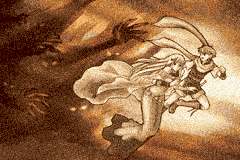
Eliwood and his troops set sail to the island with the help of the pirate captain Fargus. Along the way, they find Ninian in a small boat. She unfortunately has amnesia, and her brother Nils is not with her, which Lyn finds highly suspicious. Eliwood and company reach the island, but along the way, the group discovers Leila's corpse. Jaffar, one of the Black Fang’s Four Fangs, killed her when Ephidel discovered that she was a spy. After Eliwood finds the temple housing the Dragon's Gate, Ephidel captures Ninian, and Eliwood’s group assaults the temple to rescue her. After the battle, Eliwood finds his seriously injured father near the back of the temple. Nergal and Ephidel appear with the captured Ninian. Nergal feeds Elbert’s soul into Ninian, forcing her to summon a Dragon, but as it emerges from the portal, Nils comes in and brings Ninian to her senses. She immediately closes the portal, destroying both Ephidel and the dragon. Nergal attempts to take Ninian and Nils, but when Elbert wounds him, he flees to recover. Elbert then dies in his son's arms.
To the Shrine of Seals (20 (21H) - 28 (30H))
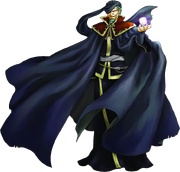
Nergal, insane Dark Druid and primary antagonist of the story.
Eliwood and company head back to the mainland to inform Marquess Uther of what has been happening. Uther is troubled by the news, and suggests that Eliwood go to the Nabata Desert to meet a "living legend." This person turns out to be Archsage Athos, one of the veterans of the Scouring, whose lifespan has been lengthened because of his deep connection to magic. Eliwood assists a mysterious Sage in the desert named Pent, who turns out to be the Mage General of Etruria. Athos tells them to find the Shrine of Seals in Bern if they want to stand a chance against Nergal.
After Athos teleports Eliwood's troops back to Pherae, they travel to Bern in disguise. When they reach Bern, they hear of Prince Zephiel's coming-of-age ceremony, during which Pent and his wife Louise plan to ask Hellene, the Queen of Bern and Louise's close friend, about the location of the Shrine of Seals. As the group gathers more information on the Black Fang, whose headquarters are in Bern, they are attacked by one of the sons of Brendan Reed, the leader of the Black Fang. After subduing him, Eliwood persuades him that they are not his enemy, at which point the brother decides to track Sonia, Brendan Reed's wife and the woman Nergal is using to control the Black Fang. However, Nergal's morph Limstella kills him. The other Reed brother, showing up later and finding his brother dead, blames Eliwood.
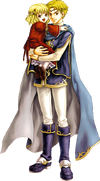
Prince Zephiel and Princess Guinivere of Bern, who take a more major role in the sequel.
Queen Hellene agrees to provide Eliwood with the location of the Shrine of Seals if he recovers the missing Fire Emblem, necessary for Zephiel's ceremony. Lyn traces the Black Fang to their mountain fortress, where they hear that Jaffar is to carry out a contract to kill Zephiel. Eliwood returns to the Bern Manse and saves Prince Zephiel from a Black Fang assassination, meeting Jaffar and Nino, Sonia’s adopted daughter, along the way. A grateful Hellene then gives them a map to the Shrine of Seals.
The group stops by at the Black Fang's secondary base, the Water Temple, where Sonia kills Brendan Reed and Limstella absorbs his quintessence for Nergal. Nino and Jaffar confront Sonia about Nino's parentage, and Sonia reveals that Nino is indeed not really her child, but the daughter of a clan of magic users that she and Nergal killed. Eliwood's troops step in to defend Nino and Jaffar, and finally defeat Sonia. Limstella shows up, but does not absorb Sonia's quintessence because she does not have any, as she was a morph; she just leaves Sonia to die of her wounds, alone in the temple, still thinking she is human.
Eliwood makes it to the Shrine of Seals, where he defeats the remaining Reed brother. Athos teleports in and takes the group into the Shrine to talk to the other remaining legend, the cautious magic user Bramimond. After talking with Athos, Bramimond is persuaded to open the seals on the legendary weapons used to slay the dragons. Outside the Shrine, a fully healed Nergal shows up and tries to take Ninian and Nils. To defend her brother and gain time, Ninian goes with him in exchange for Nils' safety.

Eliwood, using the divine weapon Durandal to slay the hostile dragon.
Eliwood goes to the tomb of Roland and collects the sword Durandal from its resting place, while Hector retrieves the axe Armads. As Eliwood leaves, an Ice Dragon attacks him, and Durandal, seemingly activated on its own, slays the Dragon, which is revealed to be Ninian. Nergal returns to gloat, telling Eliwood that Ninian lost most of her memory when she became a Dragon, and that the only thing remaining was her love towards Eliwood. Ninian uses her last quintessence to change back to her human form and dies in Eliwood’s arms. Enraged, Athos attempts to kill Nergal with the spell Forblaze, but fails. Eliwood and Hector leave the legendary weapons in Athos' care.
Conclusion (29 (31H) - Epilogue)
Back in Ostia, as Eliwood's group recuperates, Athos tells them about Nergal's past. He and Nergal, once friends, came across the hidden village of Arcadia, where humans and dragons lived in peace. Nergal spent his time there learning the secrets of acquiring quintessence, which slowly distorted his soul. Athos and the residents of Arcadia teamed up to defeat Nergal, but he managed to escape and fled to Bern, taking control of the Black Fang while he was there. Hector also learns that his brother has died.
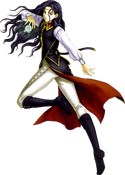
Limstella, strongest of the morphs and the perfect creation of Nergal.
Nergal, back at the Dragon's Gate, uses Ninian's quintessence to open the portal, but he does not have enough. Eliwood arrives at the Dread Isle and defeats Limstella. Nergal then channels quintessence from the most powerful human leaders and creates morph versions of them, sending them out to destroy Eliwood’s group, but they fail. Then Nergal himself appears but is also defeated; with his dying breath, he summons three Fire Dragons. Bramimond intervenes and uses his remaining power to resurrect Ninian, who kills two and severely wounds the third. Eliwood's group, using the legendary weapons, manages to slay the last Dragon. After the battle, Athos collapses from exhaustion, and as he dies, predicts that "an evil star will rise... over Bern... but once again, Lycia will bring hope to cleanse the darkness," referring to the events of the previous game, Fire Emblem: Binding Blade, to which Fire Emblem: Rekka no Ken is a prequel.
One year later, Eliwood is crowned Marquess of Pherae in his father's place, and soon Hector is crowned as Marquess of Ostia.
Fifteen years later, Eliwood and Hector meet each other in Castle Ostia, where Eliwood introduces his son Roy and Hector introduces his daughter Lilina. While the children play, Eliwood and Hector talk about some events in Bern related to Archsage Athos' predictions. Interestingly, Lyn isn't mentioned although this may be because she has no role in Binding Blade, or simply because she can marry either Eliwood or Hector. In the final scene of the game, Zephiel, now the King of Bern, is talking with an enigmatic man, who is inquiring him as to why he awoke the Demon Dragon. To these, Zephiel simply makes a chilling smile.
Gameplay
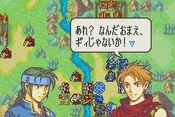
Recruitment dialogue between Matthew and Guy in the Japanese version of the game.
Fire Emblem's gameplay is very similar to Fire Emblem: Binding Blade's. The fundamentals remain the same, with a small group (usually 10 to 12) of units moving along a square-based grid with the objective of defeating or surviving their enemies. It is reminiscent of other tactical RPGs with features such as classes and the ability to level up. For more information, refer to the Fire Emblem game basics.
Tutorial
While Fire Emblem reuses most of its gameplay mechanics from Binding Blade, it introduces some notable changes. Perhaps the most significant difference is the introduction of a tutorial mode (Lyn's Tale). The single-player campaign is divided into Lyn's tale and Eliwood's tale, the former of which serves as a mandatory tutorial designed to ease new players into the game. The tutorial disappears in Lyn's Hard Mode, which is unlocked after the normal mode is complete.
Combat
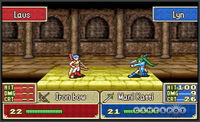
Combat in Fire Emblem between a lord, Lyn, and a Laus archer.
Fire Emblem, like all the other games in the series, is a turn-based strategy RPG in which players move characters around a grid—much like a chessboard—in order to complete a certain predefined objective like capturing an enemy base or surviving a certain amount of turns. The single-player campaign is divided into chapters which begin with story elements presented through the use of scenes animated with cut-outs of the main characters, followed by a battle with an enemy; after each chapter, the player is given the opportunity to save their progress. Fire Emblem also includes an autosave feature, which ensures that progress is not lost if the console is unexpectedly turned off (when the battery power is depleted, for instance). Also, aside from capturing bases and defeating bosses, Fire Emblem introduces new mission objectives like surviving a certain number of turns, destroying all enemies, and traveling to a predefined space on the map. In addition, weather and terrain effects like rain and snow, which hinder unit movement, have been added.
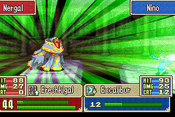
Nino, fighting Nergal, is currently at a disadvantage due to the Magic Trinity as Excalibur (Anima) is inferior to Ereshkigal. (Dark)
Each unit has statistics for categories like power, speed, defense etc. The advantage a unit has on another unit depends on the statistical differences of the units. The game follows a rock-paper-scissors mechanism in which axes beat lances, lances beat swords, and swords beat axes; the bow in the game is not a part of any weapon triangle, but is specially effective against flying units. Similarly, the magic system is also structured through a triangle, the Trinity of Magic, in that dark magic has the advantage over anima magic, anima over light magic and light magic over dark magic.
Units
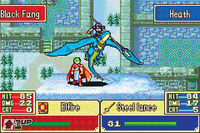
Heath, one of the only two Wyvern characters available to the player in the game, engaged in battle against a Black Fang Sage.
All of the forty-four units in Fire Emblem are divided into classes; such classes include Shaman, Berserker, Thief, etc. A unit can use either magic or weapons; the "weapons" category comprises swords, axes, lances and bows; the "magic" category comprises anima (or elemental) magic, dark magic, light magic and staves (used for functions such as healing and curing status ailments). There are different levels of weapon; the levels run typically from E to A in alphabetical order and then to the ultimate level which is S; a unit can raise their weapon level by persistently using that weapon. Which item the unit can use in battle depends on their respective class; most units cannot use all four weapons within a category. The units become more powerful by "leveling up", the unit gains a level by attaining one-hundred experience points. An unpromoted unit can change class (promote) once it has surpassed level ten, however, it requires the aid of a special item to do this. The "special item" varies depending on the class that it is intended for, but they are usually small items symbolic of their class, such as the Knight's Crest for knights or cavaliers. These items can be found during the course of the game. Alternatively, the player can wait to use the item until the unit reaches the optimum level of twenty (or any other level between ten and twenty) before the unit promotes. Once promoted, the maximum level the unit can reach is level twenty of the promoted class.
Supports
In Fire Emblem, the level of "support" between units depends on how many turns the units have spent adjacent to one another. Support is the statistical gain between units when they are within three spaces of each other; the statistical bonus is strengthened if the support level is higher. The level of support is measured C to A—C for a single conversation, B for two conversations, and A for three conversations. Each unit has an elemental affinity; the form of statistical bonus from supports will depend on the combination of the elemental affinities of both units. For the support level to increase, it is required for units to be adjacent for more turns. For each support, a readable conversation will occur between the two characters. Once the story mode is completed, a "support viewer" will become available in which the reader can read previously viewed conversation at will.
As with all Fire Emblem games, if a unit falls in battle, he or she can never be used again. However, an exception is made for characters in Lyn's tale, who will return in Eliwood's tale even if they are defeated during Lyn's tale. If one of the Lords (Eliwood, Hector, and Lyn) dies, the player must restart the chapter to continue the story.
Alternative Modes
Hector's Tale
Hector's tale is unlocked after the player completes Eliwood's tale once. It is almost the same as Eliwood's, but with a few changes.
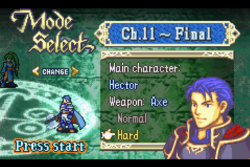
The Select Mode Menù
- Hector, instead of Eliwood, is the main character. Several story elements and cut scenes are changed to reflect the change in the point of view.
- Two normal chapters (and two Gaiden chapters) are added and several chapters are changed to reflect the different point of view. In all chapters, there are different troops and troop placement, and the level of difficulty is higher.
- Additional details concerning Nergal, Ninian, and Nils' past are revealed after particular side chapters called the "Kishuna chapters".
- Two characters not found in Eliwood's mode can be recruited: Farina, the third of the Pegasus Knight sisters, and Karla, the Princess of Swords, sister to the Swordmaster Karel.
Hard Mode
There is a hard mode for each of the Lords' tales. Hard mode changes include more difficult landscape conditions (the use of fog for example, which limits sight of enemy), higher-leveled enemies, and a reduced level of applicable units in battle. The most dramatic change between normal mode and hard mode is in Hector Hard Mode. Hector Hard Mode involves higher leveled enemies, enemies with greater AI, and fewer units available during chapters. It is also more difficult to generate money and sustain the group with weapons and resources, as less gold is available and earning it is more difficult.
Multiplayer
As well as the single-player campaign, Fire Emblem features a link arena similarly to Binding Blade and later Sacred Stones in which up to four players can link up and do battle with teams of characters from the single-player save file. Players choose up to five characters and equip them like in the main story. During battle, each player takes turns to attack with one character. Players can also choose to fight against their own teams, which are controlled by the computer, if no other players are present.
Sound Room
See Main Article: List of Music in Fire Emblem: Rekka no Ken
Weapons
See Main Article: List of weapons in Fire Emblem: Rekka no Ken
Items
See Main Article: List of items in Fire Emblem: Rekka no Ken
Reception
The popularity of Marth and Roy in Super Smash Bros. Melee partly influenced Nintendo to localize Fire Emblem games to North America and Europe. This is the first Fire Emblem game released outside of Japan, and it was designed with localization to North America in mind. Since its release in North America and Europe, each new installment of the Fire Emblem series save for Fire Emblem: Shin Monshō no Nazo ~Hikari to Kage no Eiyū~ has been seen an international release in Western markets.
Fire Emblem has received praise from many critics for its epic story and unusually deep character development and gameplay. The game has received many high ratings including an 8.9/10 from GameSpot (making it one of the top 20 rated GBA games on the site) and it has received the coveted Editor's Choice Award from both IGN and GameSpy. In 2007, it was named 16th best Game Boy Advance game of all time in IGN's feature reflecting on the Game Boy Advance's long lifespan. Fire Emblem sold over 345,000 units in Japan and 331,000 units in North America. Also on IGN, in 2012, Fire Emblem was ranked 83rd on their Top 100 RPGs of All Time feature.
Virtual Console Re-release
On May 14, 2014, Fire Emblem: Rekka no Ken was available to download in Japan on the Wii U from the Japanese Nintendo eShop as a Virtual Console title for 702 yen. On December 4, 2014 it became available to download in North America on the Wii U Virtual Console.



